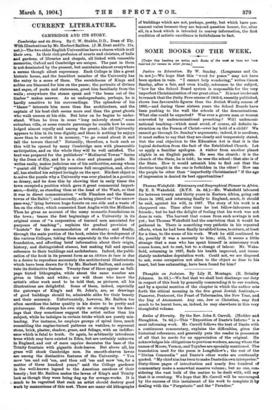Cambridge and its Story. By C. W. Stubbs, D.D., Dean
of Ely. With Illustrations by Dlr. Herbert Railton. (J. M. Dent and Co. 21s. net.)—The two older English Universities have a charm which is all their own. In their rich profusion of courts and cloisters, of halls and gardens, of libraries and chapels, all linked with venerable memories, Oxford and Cambridge are unique. The past in them is not dominated by the present, but maintains almost everywhere a serene though silent supremacy. Each College is like a great historic house, and the humblest member of the University has the entry to a score of them. The escutcheons of Kings and nobles are blazoned for him on the panes; the portraits of divines said sages, of poets and statesmen, greet him familiarly from the walls ; everywhere the stones speak and "the beam out of the timber" makes answer. As an undergraduate, perhaps, he is hardly sensitive to his surroundings. The splendour of his "blazer" interests him more than fine architecture, and the captain of his boat club seems more real than the great ghosts who walk unseen at his side. But later on he begins to under- stand. When he lives in some "long unlovely street," some suburban villa, or some remote parsonage he recalls how he once lodged almost royally and among the great; his old University appears to him in its true dignity, and there is nothing he enjoys more than to revisit it in memory, "to go round about it and tell the towers thereof." Naturally, therefore, a book such as this will be opened by many Cambridge men with pleasurable anticipation, and on the whole they will be well satisfied. The text was prepared for the publishers' "Mediaeval Towns" Series by the Dean of Ely, and he is a clear and pleasant guide. He writes easily, makes judicious use of his authorities, among whom "quaint old Fuller" rightly receives full recognition, and, above all, has studied his subject lovingly on the spot. His first object is to solve the puzzle why a University was ever planted in a position so dreary, and he does this by showing that in early times the town occupied a position which gave it great commercial import- ance,—firstly, as standing then at the head of the Wash, so that it was in direct communication "with Flanders and the Hanse towns of the Baltic"; and secondly, as being placed on "the narrow pass-way," lying between huge forests on one side and a waste of fen on the other, which connected East Anglia with the Midlands. Then he gives an account of the many monastic foundations in the town ; traces the first beginnings of a University in its original sense of "a corporation of learned men associated for purposes of teaching" ; explains the gradual provision of "hostels" for the accommodation of students; and finally, through the main portion of the book, relates the development of the various Colleges, taking them separately in the order of their foundation, and affording brief information about their origin, history, and distinguished alumni, but making full and special reference to their buildings and architecture. Indeed, the publi- cation of the book in its present form as an edition de luxe is due to a desire to reproduce accurately the architectural illustrations which have been drawn for it by Mr. Herbert Railton, and consti- tute its distinctive feature. Twenty-four of these appear as full- page tinted lithographs, while about the same number are given in black and white ; nor will those who know the artist's other work need to be told that, as pictures, all his illustrations are delightful. Some of them, indeed, especially the gateways of King's and St. John's, are, as drawings of good buildings should be, admirable alike for their beauty and their accuracy. Unfortunately, however, Mr. Railton too often sacrifices the latter quality in his desire to be pretty and picturesque. He stamps his own style so strongly on his draw- ings that they sometiines suggest the artist rather than his subject, while he indulges in certain tricks which are purely mis- leading. For instance, he employs groups of spiral lines, much resembling the engine-turned patterns on watches, to represent stone, brick, plaster, shadow, grass, and foliage, with an indiffer- ence which is fatal to truth. Or again, be arbitrarily introduces trees which may have existed in Eden, but are certainly unknown in England, and out of mere caprice decorates the base of the Trinity fountain with gigantic dock-leaves. But above all, his grass will shock Cambridge men. Its smooth-shaven lawns are among the distinctive features of the University. "You mow 'em and roll 'em, and then roll 'em and mow 'em, for a matter of three hundred years," said the College gardener in the well-known legend to the American emulous of their beauty ; but Mr. Railton makes the lawns of King's and Trinity look as though they were being dug up for sewage-works. It is much to be regretted that such an artist should destroy good work by mannerism of this sort. There are many old lithographs
all, in a book which is intended to convey information, the first










































 Previous page
Previous page